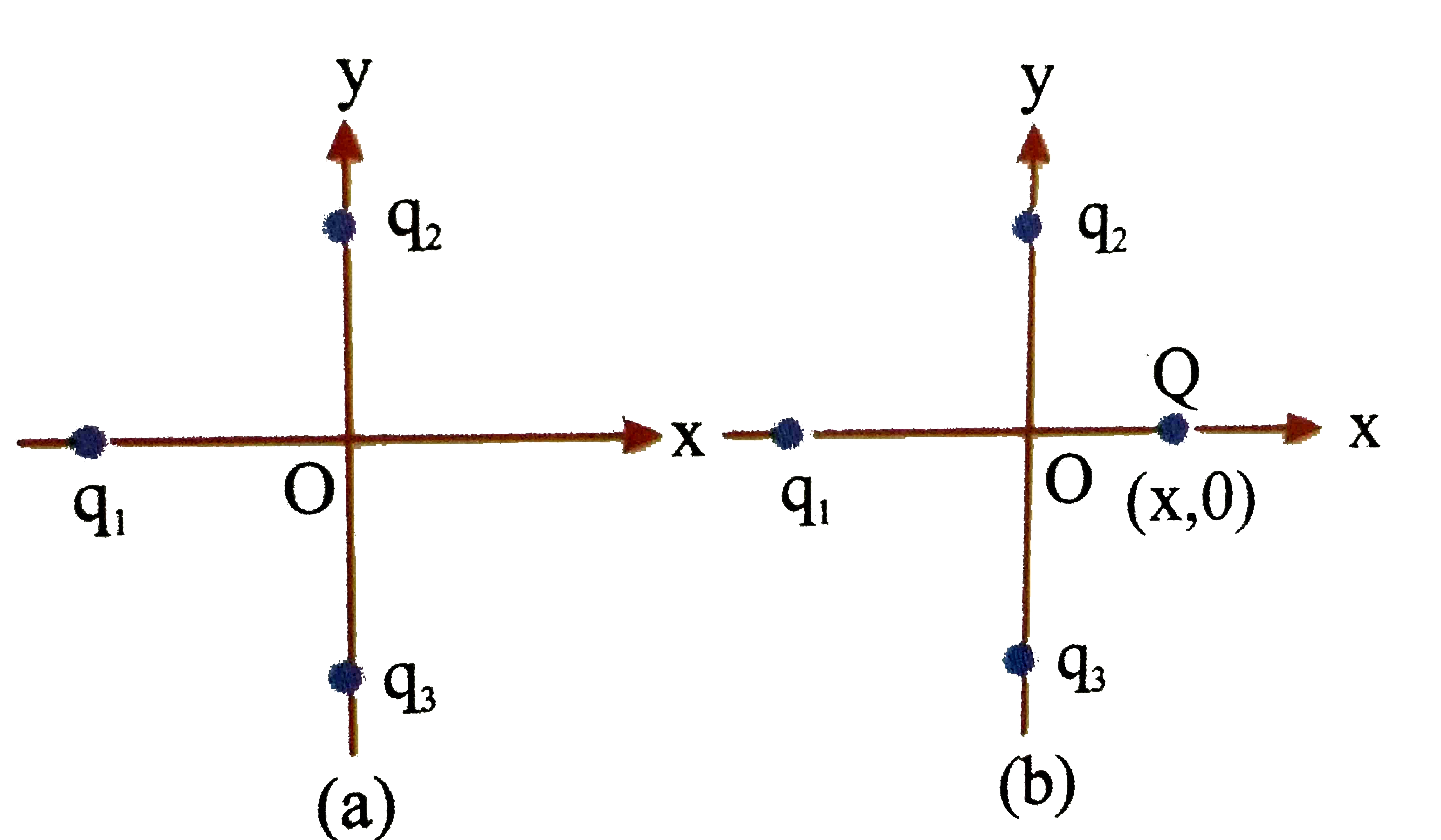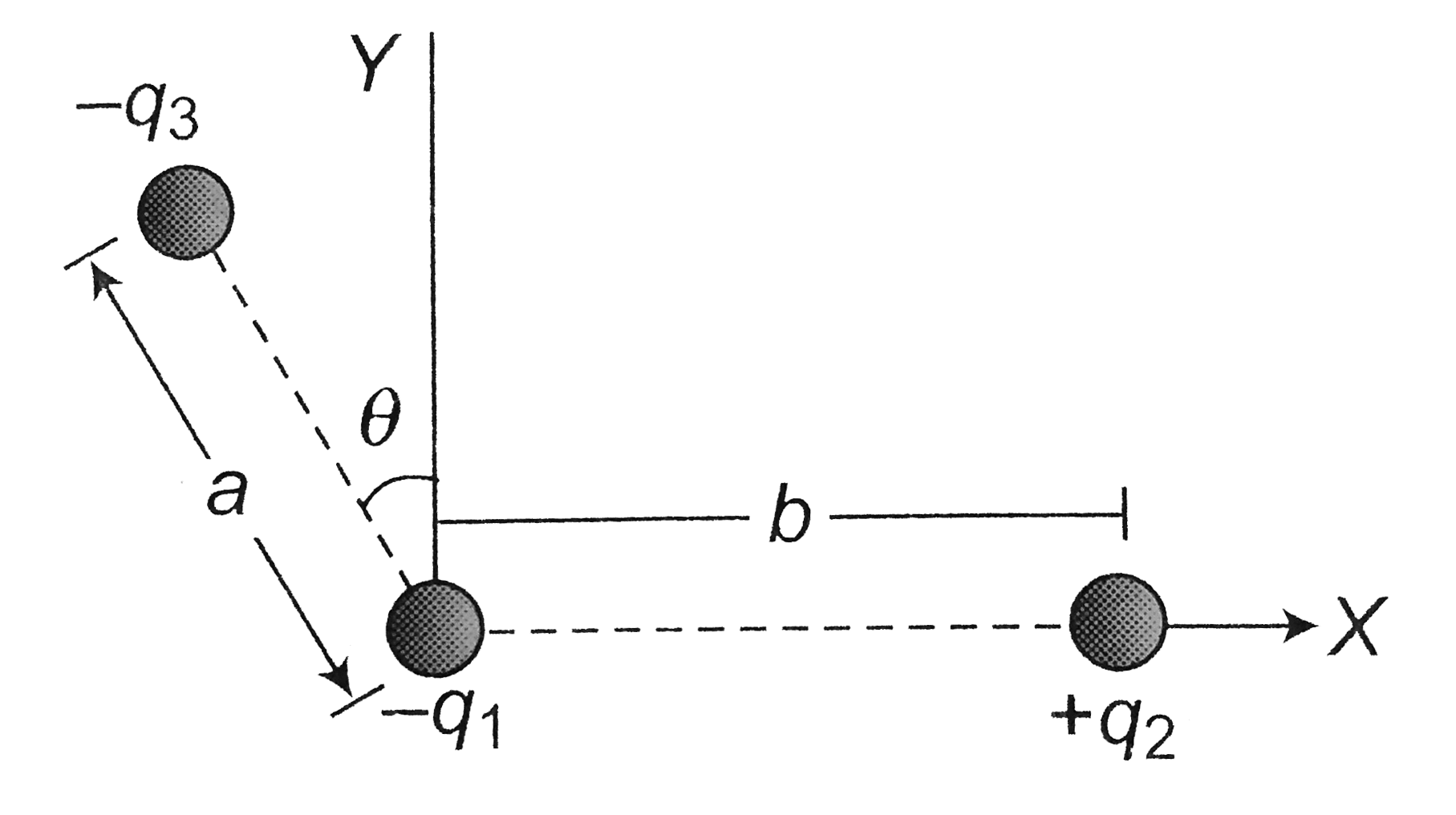In figure two positive charges q2 and q3 fixed along the y-axis ,exert a net electric force in the +x direction on a charge q1 fixed along the x-axis if a positive charge Q is added at (x,0) the force on q1

shell increase along the positive X-axis
shall decrease along the positive X-axis
shall point along the negative X-axis
shall increase but the direction changes because of the intersection of Q with q2 and q3
The correct Answer is:A
Charges q2 and q3 are given to be positive and the direction of force on q1 is along positive X-axis. Hence, charge q1 must be negative in polarity. The positive charge Q placed additionally will also attract q1 along positive X-axis. Net force on q1 will increase in the positive X-direction.
Topper's Solved these Questions
- BOOK - MODERN PUBLICATIONCHAPTER - ELECTRIC CHARGES AND FIELDS EXERCISE - Higher Order Thinking Skills & Advanced Level (Questions With Answers)5videos
ELECTRIC CHARGES AND FIELDS
- BOOK - MODERN PUBLICATIONCHAPTER - ELECTRIC CHARGES AND FIELDS EXERCISE - Revision Exercises (Very short)55videos
ELECTRIC CHARGES AND FIELDS
- BOOK - MODERN PUBLICATIONCHAPTER - ELECTRIC CHARGES AND FIELDS EXERCISE - Ncert File (Textbook Exercise)34videos
ELECTRIC CHARGES AND FIELDS
- BOOK - MODERN PUBLICATIONCHAPTER - DUAL NATURE OF RADIATION AND MATTER EXERCISE - CHAPTER PRACTICE TEST15videos
DUAL NATURE OF RADIATION AND MATTER
- BOOK - MODERN PUBLICATIONCHAPTER - ELECTROMAGNETIC INDUCTIONEXERCISE - CHAPTER PRACTICE TEST FOR BOARD EXAMINATION14videos
ELECTROMAGNETIC INDUCTION
Similar Questions
A positive point charge q1 is placed at (a,0) and another positive point charge q2 is placed at (0,a) . Find the force acting on q1.
View SolutionTwo charges q1 and q2 are kept on x-axis and electric field at different points an x-axis is plotted against x. Choose correct statement about nature and magnitudes of q1 and q2
 View Solution
View Solution
Knowledge Check
- Question 1 - Select One
In the figure two positive chargesq2 and q3 fixed along the Y-axis, exert a net electric force in the + x direction on a charge q1 fixed along the X-axis. If a positive charge Q is added, at {x, 0), the force on q1
 Ashall increase along the positive X-axisBshall decrease along the positive X-axisCshall point along the negative X-axisDshall increase but the direction changes because of the intersection of Q with q2and q3
Ashall increase along the positive X-axisBshall decrease along the positive X-axisCshall point along the negative X-axisDshall increase but the direction changes because of the intersection of Q with q2and q3 - Question 2 - Select One
The given figure gives electric line of force due to two charges q1 and q2. What are the signs of the two charges ?
 ABoth are negativeBBoth are positiveCq1 is positive but q2 is negativeDq1 is negative but q2 is positive
ABoth are negativeBBoth are positiveCq1 is positive but q2 is negativeDq1 is negative but q2 is positive - Question 3 - Select One
A positive point charge (q) is projected along (+x) axis electric field is directed along (-y) axis E=E0(−ˆj) Find trajectory of charge after x = d.
Ay=qE0dm(v0)2⋅(d2−x)By=qfE0dm(v0)2⋅(d2+x)Cy=qE0d2m(v0)2⋅(d2−x)Dy=qE0d2m(v0)2⋅(d2+x)
Two point charges(+Q) and (−2Q) are fixed on the X-axis at position a and 2a from origin respectively. At what position on the axis, the resultant electric field is zero
View SolutionTwo point charges(+Q) and (−2Q) are fixed on the X-axis at position a and 2a from origin respectively. At what position on the axis, the resultant electric field is zero
View SolutionThree charges −q1,+q2 and −q3 are placed as shown in the figure. The x-component of the force on −q1 is proportional to
 View Solution
View SolutionThree charges −q1,+q2 and −q3 are placed as shown in the figure. The x-component of the force on −q1 is proportional to
 View Solution
View SolutionThe given figure gives electric line of force due to two charges q1 and q2. What are the signs of the two charges ?
 View Solution
View Solution

